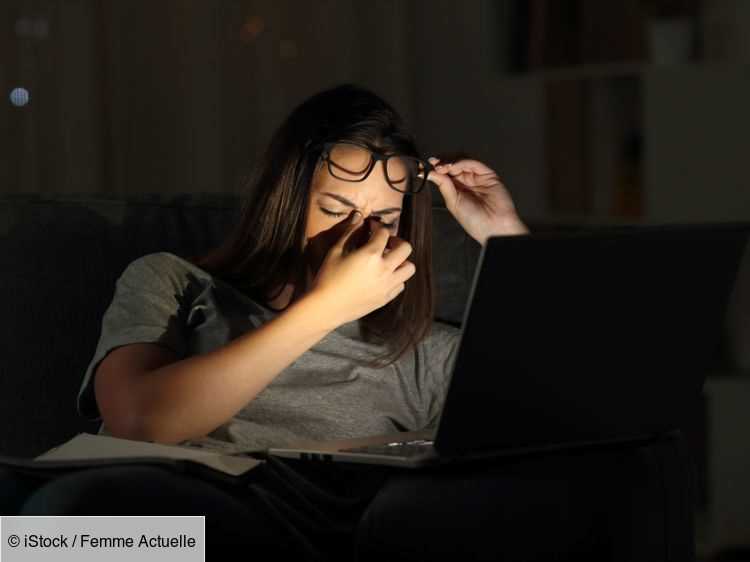To keep in touch with loved ones, work with colleagues, watch a series on Netflix, help children work or stay informed, screens are an integral part of our daily lives. And their omnipresence is all the more important in this period of confinement. Indeed, many French people stay all day in front of their screens. This exposure promotes visual fatigue, which is characterized by headaches, migraines, tingling, redness, a feeling of dry eye, blurred vision or irritated and red eyes due to heavy stress. To protect yourself and take care of your eyesight, here are some good practices to apply every day.
Wear your lenses or glasses to protect your eyes from screens
Whether glasses or lenses are prescribed to correct a vision disorder or simply to protect and rest your eyes, it is essential to always wear them in front of the screens to avoid any symptom of eyestrain. Clearly, you should not wait until the eyes are irritated or red to put them.
"To date, nothing has shown the dangerousness of lenses, even if Optic 2000 recommends the utmost caution", says the optician’s press release. It is advisable to wear glasses during this period of confinement. However, if the person wishes to wear their lenses, it is best to wash their hands thoroughly with soap and water and dry them before handling the cleaned contact lenses. After installation, it is best to empty the cases, dry them and leave them open. "The maintenance solution must be renewed after each use. The wearing and renewal frequencies of the lenses recommended by your optician must be respected", recalls Optic 2000. As for glasses, it is recommended to disinfect frames and lenses every day with soapy water to avoid any risk of contamination.
Settle well to preserve your sight
It's not enough to just wear your glasses or lenses to take care of your eyesight. Other parameters must be taken into account. When facing any screen, it is recommended to keep a distance of 50 to 70 cm. You have to adjust the screen so that it is aligned with the gaze and the eye is at the height of the center of the computer or television. Another piece of advice: it is better to opt for LCD screens than CRT screens, which tire the eyes more.
Correctly place your screen or work door
The location of the workstation is also important. Is the computer or television in front of a window? Serious error, because at any time a ray of sunshine can arrive on the screen and the information displayed will be more difficult to distinguish. Same recommendation: it is better to avoid placing a screen in front of your window, because in this case the sun will dazzle the person's eyes. In both of these situations, the eyes will be tired. To avoid reflection and glare, the screen or the workstation must always be oriented perpendicular to the window. If visual discomfort is still felt, the screen should be rotated.
Have a well-lit space
It is recommended not to place yourself under artificial light. If the lighting in the workspace or lounge is not sufficient, it should be supplemented with a lamp, if necessary. Artificial light must be at the same level as the brightness emitted by the screen and must be placed within 3 meters. Another recommendation: never use a screen in the dark.
Take regular breaks to take care of your eyes
To reduce the risk of visual fatigue, it is advisable to take a 10-minute break every two hours, that is to say a moment during which the screens are distant. There is no question of leaving your computer to use your phone. The pause time is variable and depends on the use and the duration of use of the screen. This moment of respite allows the eyes to moisten properly.
Anti-screen tip: palming to relieve your eyes
Palming is a technique of hiding your eyes from the light with the palm of your hand. This allows the eyes to rest when the first symptoms of eyestrain appear or when there is a decrease in concentration. To carry out this method, it is necessary to place its hands in shell, the fingers well joined and then to place its palms in front of each eye. Make sure that the edge of each hand is against the wing of the nose and that the light does not pass. Once darkness is complete, close your eyes and keep them there for at least 30 to 45 seconds. Small clarification: the palming sessions can last up to 20 minutes.
Get up to protect your eyesight
It is recommended to move as soon as possible: go to another room or get some air in your balcony. This allows the eyes to observe a different environment and also allows the eye muscles to work in a different way.
Another tip: look away and blink
To avoid drying of the eye and blurred vision, it is recommended to look at the horizon and look away for 20 seconds every 20 minutes. During this moment, you must fix a distant point on the right then on the left and blink regularly, whether you are facing a screen or not. This advice restores the frequency of blinking to normal.
Adjust the brightness of your screen
Whether it's a computer, phone or tablet, it's important to adjust the screen brightness based on the environment you are in. If the brightness is too strong in relation to your work or relaxation space, you must reduce it but keep enough brightness to be able to read or watch the information without any difficulty. If not, increase the brightness if you are in a well-lit room.
Read also :
⋙ Containment: 6 tips from a shrink to support co-confined people
⋙ Containment: 10 healthy recipes with three times nothing
⋙ Confinement: can you shop more than a kilometer from your home?
